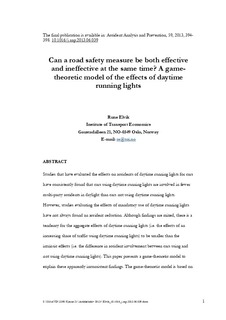| dc.contributor.author | Elvik, Rune | |
| dc.coverage.spatial | Norway | nb_NO |
| dc.date.accessioned | 2019-06-28T08:05:29Z | |
| dc.date.available | 2019-06-28T08:05:29Z | |
| dc.date.created | 2014-01-29T23:00:19Z | |
| dc.date.issued | 2013-07-06 | |
| dc.identifier.citation | Accident Analysis and Prevention. 2013, 59 (October), 394-398. | nb_NO |
| dc.identifier.issn | 0001-4575 | |
| dc.identifier.uri | http://hdl.handle.net/11250/2602711 | |
| dc.description.abstract | Studies that have evaluated the effects on accidents of daytime running lights for cars have consistently found that cars using daytime running lights are involved in fewer multi-party accidents in daylight than cars not using daytime running lights. However, studies evaluating the effects of mandatory use of daytime running lights have not always found an accident reduction. Although findings are mixed, there is a tendency for the aggregate effects of daytime running lights (i.e. the effects of an increasing share of traffic using daytime running lights) to be smaller than the intrinsic effects (i.e. the difference in accident involvement between cars using and not using daytime running lights). This paper presents a game-theoretic model to explain these apparently inconsistent findings. The game-theoretic model is based on so called Schelling-diagrams, originally introduced by Nobel laureate in economics Schelling. The effects of daytime running lights are modelled by means of Schelling-diagrams. It is shown that it is by no means impossible for cars using daytime running lights to always be safer than cars not using daytime running lights, while the total number of accidents remains constant even if the percentage of cars using daytime running lights increases from, say, 10% to 90%. | nb_NO |
| dc.language.iso | eng | nb_NO |
| dc.publisher | Elsevier | nb_NO |
| dc.rights | Attribution-NonCommercial-NoDerivatives 4.0 Internasjonal | * |
| dc.rights.uri | http://creativecommons.org/licenses/by-nc-nd/4.0/deed.no | * |
| dc.title | Can a road safety measure be both effective and ineffective at the same time? A game-theoretic model of the effects of daytime running lights | nb_NO |
| dc.title.alternative | Can a road safety measure be both effective and ineffective at the same time? A game-theoretic model of the effects of daytime running lights | nb_NO |
| dc.type | Journal article | nb_NO |
| dc.type | Peer reviewed | nb_NO |
| dc.rights.holder | © 2013 Elsevier Ltd. All rights reserved. | nb_NO |
| dc.description.version | submittedVersion | nb_NO |
| cristin.unitcode | 7482,0,0,0 | |
| cristin.unitname | Transportøkonomisk institutt | |
| cristin.ispublished | true | |
| cristin.fulltext | preprint | |
| cristin.qualitycode | 1 | |
| dc.identifier.doi | 10.1016/j.aap.2013.06.039 | |
| dc.identifier.cristin | 1104112 | |
| dc.source.journal | Accident Analysis and Prevention | nb_NO |
| dc.source.volume | 59 | nb_NO |
| dc.source.issue | October | nb_NO |
| dc.source.pagenumber | 394-398 | nb_NO |
| dc.relation.project | Norges forskningsråd: 210486 | nb_NO |

